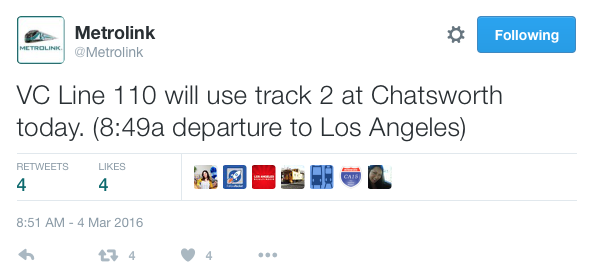Not a "rural" station but, Chatsworth (CWT) California is similiar. It is an un-staffed Amtrak and Metrolink shared station. Southern California's Metrolink does the dispatching. Of the two tracks, Track One, the main, is closest to the building and parking lot. Track Two is actually a long (11,555') passing siding and also has a platform. Coming from the south, trains are rounding a curve so its not until last minute that one can visually determine which track is actually being used.
In the morning, the southbound Pacific Surfliner #768 is scheduled to arrive 0840; the northbound #1761 at 0833. Typically (at least on weekends when I can listen on the scanner or observe) The northbound takes track 2 (furthest from the station) and is the track on the left when facing the direction of travel. The southbound arrives on Track 1 (the main). Most people, based on our driving on the right side of the road convention here, wait on track 1 for the northbound - on the right. A fence separates the two tracks and there is only one ped crossing as the south end of both platforms. There is always a certain amount of scrambling to get over to the correct track to board the northbound train. At times, one train or the other will hold out of the station to allow passengers to get where they need to be. Sometimes the trains are reversed (a dispatching decision) and the normal is not!
Amtrak posts on signs at the south end of the platform, which tracks are "normally" used for trains. As stated, this information is at the south end; the ticket machines, the building (closed on weekends), and most of the parking is at the north end...where most passengers congregate for either train. Metrolink has scrolling LED signs on the platform but they are rarely utilized on weekends (Metrolink does not run weekend trains on this route (Ventura Sub ex-SP Coast Line). Use of these signs could really help lower the confusion factor.
I have a familiarity with the territory and can "read" the signals both north and south of the station which will allow me to be on the correct platform but, the general public does not posess that kind of knowledge. One morning a while back, we were headed north from the station. Another passenger, insisting on what Amtrak's info sign said, positioned himself on the opposite platform for track 2 (the one stated for that train). Having noted the signal aspects being displayed, I stayed on track one. It was one of those mornings when things were reversed. When the train arrived on the "wrong" track, the scramble began.
Not only this station but others as well, Amtrak and the host railroads could do a much better job of providing information on arriving/departing trains.




